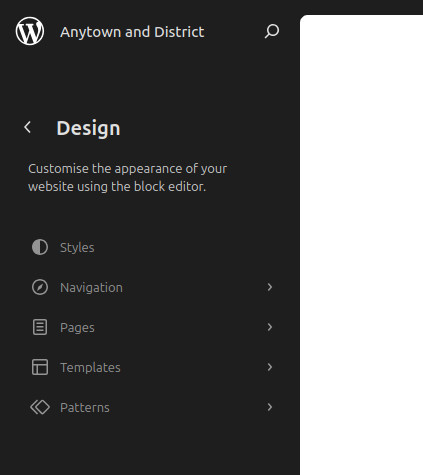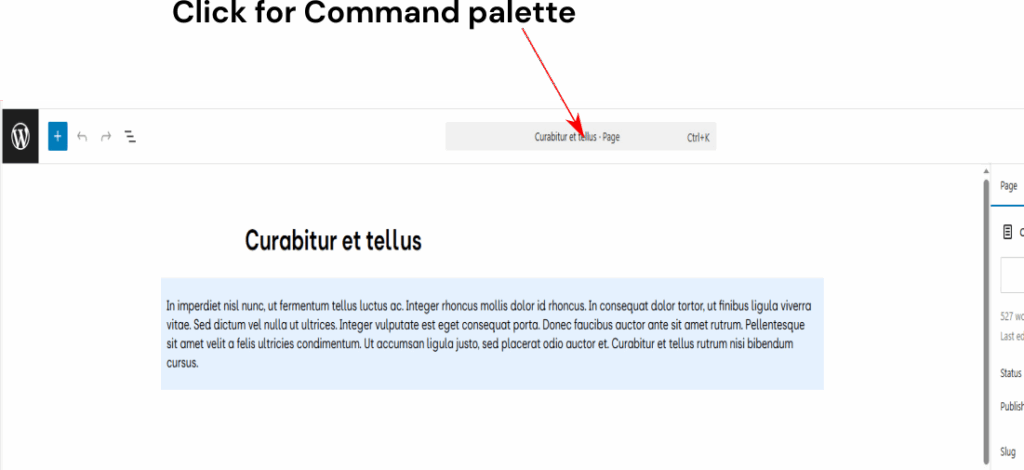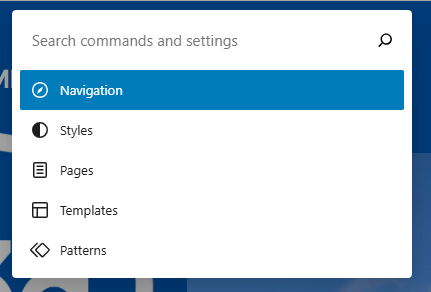Introduction #
The site editor can only be accessed by users with Administrative privileges.
To edit certain aspects of a u3a website, it is necessary to use the Site Editor. In particular, when the administrator needs to make a global change to the site, e.g. adjusting the font in every paragraph block.
The Site Editor is selected by navigating to Appearance ⇒ Editor from the Dashboard sidebar menu, which opens the Design page.
The search icon, located to the right of the pane or accessible via the keyboard shortcut Cmd+k on Mac or Ctrl+k on Windows, allows access to the Command Palette, which is discussed at the end of this guide.
On opening the Site Editor, the following pane is shown:
The available options on the Design menu are as follows:


The overall style should not be changed as it will produce a site that does not conform to u3a branding.
Styles #
The following global style options are available:
Typography #
Determines the font to be used; the system is configured to use the standard u3a font, though a limited number of other fonts are available.
Colours #
The colours of the text, background, links, etc. The standard u3a colour palette is loaded as a default.
Background #
A background image for the complete site can be added, but this is not recommended due to accessibility issues.
Shadows #
Allows the global configuration of the shadow option.
Layout #
Sets the size of the main display area; this should be left as 840 × 1100.
Blocks #
The settings of the individual blocks are predefined by the Theme, but can be modified by using the options provided in the Blocks section of the Style section. Any changes made here are applied across the site. If the administrator or content creator is a more advanced user, additional CSS code can be added as required; this will be reflected across all instances of a specific block across the site. The Additional CSS option is selected from the three vertical dots to the right of Styles.
Note: You can modify how an individual block is displayed on a specific page or post by using the Style and Settings options in the block’s right-hand sidebar.
Navigation #
This allows the editing of the Navigation menu(s). While WordPress allows for multiple menus, typically a u3a will only have one, which is identical on all pages (this is called the SiteBuilder menu for historic reasons). The design and management of multiple navigation menus are currently outside the scope of this documentation. Selecting Navigation displays the curated blocks used by the site visitors to navigate the u3a site.
It should be noted that the Template for the Welcome page has precedence over all other page and post templates, so it is typically the only one that a u3a site administrator is normally concerned with. To allow editing, with Welcome highlighted, select the edit icon, and the navigation menu can then be edited as discussed here.
Pages #
This provides a complete list of pages within the site. The content creator can select an individual page for further details, and if the page or the edit symbol is selected, the content creator can edit the page using the block editor. It should be noted that the Headers and Footers are locked, as these can only be edited through Templates. On completing any edit, Save the page (not Publish as in the Block Editor).
Templates #
This option allows the editing of the following templates:
- Archive page for posts. It is expected that this will not be required in any u3a application.
- Front Page allows the editing of the Front Page Headers and Footer as discussed here. This template has precedence over all other templates. It should be noted that the page can also be called the Home or Welcome page.
- Index. The Fallback page is used when a more specific template is not defined. It is expected that this will not be required in any u3a application.
- Page 404. Default page if a link is not found. It is recommended that the Header and Footer are not edited from this page; however, the text can be selected, and additional information can be added – for example, Contact the Website Administrator if an unavailable link is found. If the text is modified, select Save before returning to the available options.
- Pages: The default template to display any Page and Post. It is expected that this will not be required in any u3a application.
- Search Results. The Template is used to present the results when a search is undertaken. It is expected that this template may need some modification in specific u3a applications.
- Single Posts. The template is used when a single post on your website is displayed unless a custom template has been applied to that post or a dedicated template exists. A change to this template will not be expected in any u3a application.
Patterns #
Allows the editing and management of the Patterns used in the website. A Pattern in WordPress is a predefined collection of one or more blocks that can easily be inserted into the site’s WordPress posts, pages, etc. The following options are available
- My patterns. These are the patterns created by the website’s administrators and content creators, as discussed here.
- Header and Footer templates.
Command Palette. #
To select the Command Palette, either:
- Enter Cmd+k on Mac or Ctrl+k on Windows. The Command Palette can be selected from both the Site Editor and Dashboard windows.
- When editing a page or post, click on the title, as shown below:

On selecting the Command Palette, the default window shown on the left will appear, which gives the content creator the following option:
- The ability to search for commands across WordPress and the specific site.
- Rapidly access the key option of the Site Editor.
Information on the Command Palette is available from WordPress.





